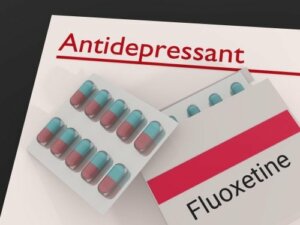Fluoxetine: Uses and Side Effects

Fluoxetine is an antidepressant medication that belongs to the selective serotonin reuptake inhibitor (SSRI) group. It works by selectively inhibiting the reuptake of serotonin by the presynaptic nerve membrane. In this manner, it increases the effect of this neurotransmitter.
Additionally, fluoxetine exhibits very few anticholinergic and sedative side effects. We’ll tell you what conditions doctors prescribe it for, and, also, what precautions patients should take.
Fluoxetine indications

Fluoxetine has several indications in adults. However, the most well-known is for the treatment of mild to severe depression. It’s commonly used to treat anxiety, as well as obsessive-compulsive disorder (OCD). Doctors also prescribe it to treat some eating disorders, such as bulimia nervosa. In these cases, patients take the medication as a complement to psychotherapy.
Doctors prescribe fluoxetine to adolescents and children as young as 8 to treat moderate to severe depressive episodes that don’t respond to psychological therapies. However, for these patients, treatment should always be a combination of medication and psychotherapy.
How to take fluoxetine
This medication is available in dispersible tablets and also capsules for oral administration. Patients can take it with or without food. However, if they experience gastrointestinal problems it’s best to take the medication with some type of food.
Patients usually take it in the morning, initially with a small dose that you might increase according to your doctor’s instructions. It’s best not to take it at night, as it can affect sleep. However, sometimes doctors will instruct patients to separate the dose and take it twice per day.
Additionally, the body absorbs fluoxetine rapidly. The medication reaches peak plasma concentrations after 6-8 hours. It’s thoroughly metabolized by the liver, giving rise to its active metabolite, called norfluoxetine.
Patients eliminate fluoxetine primarily through urine. Most of the drug leaves the body in its metabolite form, and a small percentage is eliminated in its unaltered form. This medication takes 4 to 6 days to be eliminated, while its active metabolite takes from 4 to 16 days. In cases of liver failure, it will take even more time to be eliminated from the body.
Discover: Types of Bulimia
Dosage
Adults
The maximum dose of fluoxetine for any indication is 80 mg per day in adults. Here are the recommended doses for its different indications:
- Depression: 20 mg per day, in the morning. After several weeks of treatment, doctors can then increase the dose if necessary, up to a maximum of 80 mg/day. Patients should divide doses higher than 20 mg/day and take them separately.
- Bulimia: 60 mg/day
- Obsessive-compulsive disorder: 20-60 mg/day. Initial doses of 40-60 mg have been shown to have a faster onset of action than in patients who take 20 mg/day.
Elderly
The maximum dose of fluoxetine for this patient population is 60 mg per day. Generally, doctors recommend a dose of 20 mg/day. They rarely prescribe doses greater than 40 mg/day. In cases of severe liver malfunction or kidney failure, the dose must be reduced to 20 mg every 48 hours.
Contraindications

Contraindications of fluoxetine include:
- Fluoxetine allergy
- Interaction with monoamine oxidase inhibitors (MAOIs). Doctors shouldn’t administer fluoxetine in combination with MAOIs, or within 14 days following the end of treatment with MAOIs. Since fluoxetine and its active metabolite have long elimination half-lives, patients should wait a minimum of 5 weeks after treatment with fluoxetine before beginning treatment with an MAOI.
- Severe kidney failure
- Uncontrolled epilepsy
Adverse effects of fluoxetine
The adverse effects of fluoxetine are generally frequent, although moderately severe. In the majority of cases, adverse reactions involve a prolonged pharmacological action and mainly affect the central nervous system.
The most common adverse reactions are:
- Headache
- Nausea and diarrhea
- Anxiety and insomnia
- Anorexia and weight loss
However, patients occasionally experience effects such as tremors, dizziness, dry mouth, mania, or hypomania. Additionally, sometimes they experience asthenia, sedation, decreased sex drive, sweating, abdominal pain, itching, flu-like symptoms, palpitations, and also urinary incontinence.
Less commonly reported are convulsions, akathisia, ataxia, hallucinations, neuropathy, psychosis, stomatitis, gingivitis, epistaxis, contact dermatitis, alopecia, and also hypotension. Treatment with fluoxetine should be immediately suspended if there’s any occurrence of exanthematous eruption.
You might also enjoy: Antidepressants and Alcohol: What Effects Does Combining Them Have?
Conclusion
Fluoxetine is a medication the body rapidly absorbs, but may require between 2 and 4 weeks to achieve a significant clinical effect.
https://mejorconsalud.as.com/fluoxetina-usos-y-efectos-secundarios/
All cited sources were thoroughly reviewed by our team to ensure their quality, reliability, currency, and validity. The bibliography of this article was considered reliable and of academic or scientific accuracy.
-
Mitchell, J. E., Steffen, K., Ertelt, T., & Marino, J. (2012). Bulimia Nervosa. In Encyclopedia of Human Behavior: Second Edition. https://doi.org/10.1016/B978-0-12-375000-6.00076-8
-
Tiraboschi, P., & Spagnoli, A. (1989). Fluoxetina. Medicina – Rivista Della Enciclopedia Medica Italiana.
-
Bolaños Ríos, Patricia; Cabrera Rodríguez, R. (2008). Influencia de los psicofármacos en el peso corporal. TRASTORNOS DE LA CONDUCTA ALIMENTARIA.
This text is provided for informational purposes only and does not replace consultation with a professional. If in doubt, consult your specialist.








